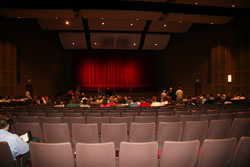Fine Arts Center improves Roncalli’s artistic image, capabilities

Photo caption: Roncalli High School’s Fine Arts Center has excellent acoustics, school officials said. (Photo courtesy Roncalli High School)
By John Shaughnessy
Chuck Weisenbach let out a small laugh, rejoicing in the reality that he no longer has to deal with the conflicts that often arise when one high school facility has to serve the needs of so many students.
Sure, the girls’ volleyball team at Roncalli High School in Indianapolis needed the gymnasium to practice as it continued its successful run for the 3A state championship. And sure, the girls’ basketball team needed the gym to get ready for its upcoming season. Yet, as the school’s principal, Weisenbach no longer has to worry about also finding time in the gym for rehearsals of the school’s upcoming play, A Christmas Carol.
Ever since Roncalli opened its new Fine Arts Center at the beginning of this year, the conflicts have lessened and the excitement has increased for a facility that has dramatically improved the school’s artistic image and capabilities.
“Obviously, we can have play practice right after school now, and they can go home and have dinner with their families,” Weisenbach said. “It’s something we don’t take lightly. They can go home and work on a big term paper or a big test. Finally, they have a facility that’s now fitting of the talents of the faculty and the students in the fine arts program.”
The arts center was created from a $4.7 million capital campaign that has also allowed Roncalli to quadruple the size of its resource center for students with special needs. Being able to serve more students with physical and mental handicaps was another priority of the school’s campaign.
“I met with literally thousands of people during the campaign,” recalled Joe Hollowell, the president of Roncalli. “Our approach was, ‘We’re the largest school in the state that doesn’t have a second gymnasium. We’re the largest school in the state that doesn’t have a performing arts auditorium. And we want to expand the number of students we can say yes to.’
“As compelling as the case for the gymnasium and the auditorium was, people were most excited about the possibility of extending our Catholic education to students who are handicapped.”
Thanks to the campaign that surpassed its $3.5 million goal, the space for the special needs resource center has grown from 600 square feet to 2,500 square feet, according to Hollowell.
The school hopes to break ground on the second gymnasium during the summer of 2007.
“We’ve also doubled the size of our guidance area,” Hollowell said. “The campaign’s success shows we’ve done our homework, and people were moved by the needs expressed that they wanted to make them happen.”
The impact of the Fine Arts Center became immediately apparent during the “Sacred Sounds” concert—the opening concert for the facility that featured sacred music performed by the school’s band and choral groups.
“Having watched concerts and shows at Roncalli for 25 years, I was blown away by the acoustical sound of the center,” Weisenbach said. “You could pick out the specific instruments. Before this, they didn’t have the facilities to let them excel at the same level of our athletes.”
The change has also echoed throughout the fine arts program, creating more artistic opportunities for students in the classroom and even enhancing the image of the school, which has 1,115 students.
“It’s allowed us to expand the curriculum,” Weisenbach said. “We knew we had twice as many kids who wanted to take a visual arts class, but we didn’t have the room. Now, we have double the number of students taking art classes. If you take all the students enrolled in a fine arts class or that are involved in a fine arts activity, it’s knocking right on the door of 800 kids. It’s awesome.
“It speaks to the community we’ve made at Roncalli and in the South Deanery—that we’ve made a commitment to the fine arts. I think there will be great momentum for the third-, fourth- and fifth-graders who come on campus and see this beautiful facility. This will appeal to students and families whose passions lie in the fine arts.”
Weisenbach couldn’t resist using a theatrical reference to describe the impact the capital campaign has had on Roncalli: “It ended up being a rousing success.” †
